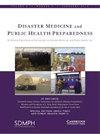评估德克萨斯州休斯顿市重复暴露于人为和自然灾害后的自我身体健康评分
IF 1.9
4区 医学
Q3 PUBLIC, ENVIRONMENTAL & OCCUPATIONAL HEALTH
引用次数: 0
摘要
背景 研究将健康结果与危险暴露联系起来,但往往忽略了暴露或重复事件的性质。方法 我们对休斯顿大都会统计区(HMSA)的代表性样本进行了横截面研究(N = 1,094)。受访者通过 Qualtrics 面板进行招募,目标受访者反映了休斯顿大都会统计区的人口情况。采用 SF-12v2 计算身体综合评分 (PCS)。结果 在各种危害(飓风、洪水、龙卷风、化学品泄漏、工业火灾)中,只有化学品泄漏显示出剂量反应:身体健康评分随着重复暴露而显著下降。经过多元线性回归后,这种下降趋势依然存在。包括性别、种族、年龄、教育程度和化学品暴露在内的相关因素都会影响 PCS,但化学品泄漏暴露仍然是影响最大的因素,即使在调整了其他因素之后,仍然会对 PCS 产生负面影响(系数 =-2.24,95% CI,-3.33 至-1.15)。结论 掌握危害(尤其是重复危害)的影响可以指导应急管理部门开展减灾、恢复和备灾工作。本文章由计算机程序翻译,如有差异,请以英文原文为准。
Assessing Self-Rated Physical Health Scores Following Repeat Exposure to Anthropogenic and Natural Hazards in Houston, TX
Background Research connects health outcomes to hazard exposures but often neglects the nature of the exposure or repeated events. Methods We undertook a cross-sectional study (N = 1,094) from a representative sample in the Houston Metropolitan Statistical Area (HMSA). Respondents were recruited using Qualtrics panels, targeting individuals reflecting the population of the HMSA. Physical composite scores (PCS) were calculated using the SF-12v2. Results Among the hazards (hurricanes, flooding, tornadoes, chemical spills, industrial fires), only chemical spills showed a dose-response: physical health scores declined significantly with repeated exposures. This decline persisted after multiple linear regression. Covariates including sex, race, age, education, and chemical exposure affected PCS, but chemical spill exposure remained the most significant, negatively affecting PCS even after adjusting for other factors (coef =–2.24, 95% CI, –3.33 to –1.15). Conclusion Grasping the effects of hazards, especially repeated ones, can guide emergency management in mitigation, recovery, and preparedness efforts.
求助全文
通过发布文献求助,成功后即可免费获取论文全文。
去求助
来源期刊

Disaster Medicine and Public Health Preparedness
PUBLIC, ENVIRONMENTAL & OCCUPATIONAL HEALTH-
CiteScore
4.40
自引率
7.40%
发文量
258
审稿时长
6-12 weeks
期刊介绍:
Disaster Medicine and Public Health Preparedness is the first comprehensive and authoritative journal emphasizing public health preparedness and disaster response for all health care and public health professionals globally. The journal seeks to translate science into practice and integrate medical and public health perspectives. With the events of September 11, the subsequent anthrax attacks, the tsunami in Indonesia, hurricane Katrina, SARS and the H1N1 Influenza Pandemic, all health care and public health professionals must be prepared to respond to emergency situations. In support of these pressing public health needs, Disaster Medicine and Public Health Preparedness is committed to the medical and public health communities who are the stewards of the health and security of citizens worldwide.
 求助内容:
求助内容: 应助结果提醒方式:
应助结果提醒方式:


